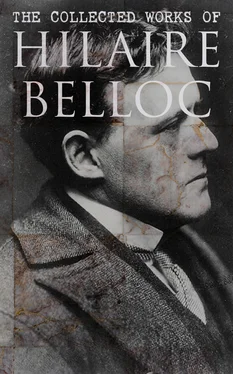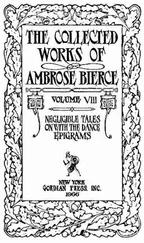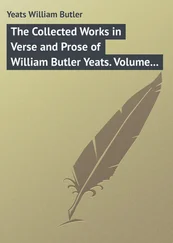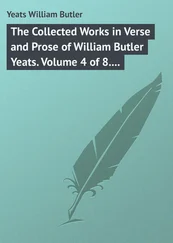Hilaire Belloc
The Collected Works of Hilaire Belloc
Historical Books, Economy Studies, Essays, Fiction & Poetry
Illustrator: Basil T. Blackwood, William Hyde, G. K. Chesterton
e-artnow, 2021
Contact: info@e-artnow.org
EAN: 4064066383459
History HISTORY Table of Contents
The Book of the Bayeux Tapestry THE BOOK OF THE BAYEUX TAPESTRY Table of Contents
The Path to Rome THE PATH TO ROME Table of Contents '. .. AMORE ANTIQUI RITUS, ALTO SUB NUMINE ROMAE'
The Old Road THE OLD ROAD Table of Contents
The French Revolution THE FRENCH REVOLUTION Table of Contents
Blenheim BLENHEIM Table of Contents
Tourcoing TOURCOING Table of Contents
Crécy CRÉCY Table of Contents
Waterloo WATERLOO Table of Contents
Malplaquet MALPLAQUET Table of Contents
Poitiers POITIERS Table of Contents
First and Last
Europe and the Faith
Survivals and New Arrivals: The Old and New Enemies of the Catholic Church
The Jews
The Historic Thames
A Change in the Cabinet
A General Sketch of the European War: The First Phase
The Two Maps of Europe
Economics
Servile State
Essays
Avril: Essays on the Poetry of the French Renaissance
Hills and the Sea
On Nothing and Kindred Subjects
On Everything
On Anything
On Something
This and That
On
The Free Press
Novels & Short Stories
The Mercy of Allah
The Green Overcoat
Poetry
A Moral Alphabet
Bad Child's Book of Beasts
More Beasts For Worse Children
The Modern Traveller
Cautionary Tales for Children
More Peers
Verses and Sonnets
Verses
Sonnets and Verse
Table of Contents
THE BOOK OF THE BAYEUX TAPESTRY
Table of Contents
At Bayeux in Normandy, a little town as old perhaps as our race and older certainly than our records and our religion, there is to be seen in the main room of what was once the Bishop’s Palace a document unique in Europe. There is no other example, I think, of a record, contemporary or nearly contemporary, of an event so remote in the story of Christendom, detailed upon so considerable a scale and relating to a matter of such moment. It is these three characters combined which give to the Bayeux Tapestry its value. We have, indeed, pictorial representation more accurate and more detailed in some few cases, but relating to the periods when material civilisation was high—before the Dark Ages. We have again an ample store of evidence pictorial and written, relating to the vivid life of the earlier Middle Ages, and of course, an overwhelming mass of matter dealing with everything that accompanied or has succeeded the Renaissance. Even of the Dark Ages and of that violent and happy transition from the Dark Ages to Mediæval civilisation, we have here and there sharp pictures—mostly pictures of the pen and not of the pencil. But these pictures relate—almost always—episodes which were not the capital episodes of their time. The Bayeux Tapestry stands quite apart in this: that it represents so faithfully and so thoroughly one of the half-dozen acts essential to the remaking of Europe, and that it so represents an act which, on the analogy of every other of that early time, we should expect to receive only from a short and doubtful literary account. It is the one picture we have of any magnitude showing us the things of the Crusading turning-point. For Western Christendom, as we know, awoke from its sleep and flowered into the Middle Ages through three great efforts: The Norman Adventures, the Reform of the Church under St. Gregory VII, and the Crusading March. All these were the product of a sort of spring which came upon our ancestry more than eight hundred years ago, and which restored in a renewed form the civilisation of the West. Of that spring the Bayeux Tapestry remains the one piece of ocular description which has survived.
Unfortunately, there must be added to this statement (which would be final if we could be certain of our dates) a critical warning. The date of the work is not certain. I will set forth in a moment the arguments which have been put forward for fixing the work to this or to that moment. We can happily be certain beyond reasonable doubt that it was produced within the lifetime of men who could remember the Invaders of England. It is not later than that. It has even been believed to be actually contemporary with the Invasion itself, and produced under the direction of those who took part in the expedition. But though it is virtually a contemporary document, even if we find ourselves compelled to accept the lower of these limits, yet we unfortunately have not a definite proof of the year or years in which the work was finished. This is the one point which mars our satisfaction in our possession of this thing. It is here worthy of curious remark that the history of the English is singularly fortunate in the wealth of record which it has at call. No other nation has such an accumulation of ancient testimony to hand. No other nation has such a document as the Anglo-Saxon Chronicle or as the Doomsday Survey , and, by an accident both of civil and of religious history, no other nation has preserved through the revolutions of a thousand years so much material record undestroyed.
When a man first sees the Tapestry at Bayeux his immediate impression and his most vivid one is the impression occasionally, but rarely, produced by some perfect architectural relic—an impression of liveliness as though time had been telescoped up for his advantage. I say that this impression is rare, but when we do get it, it is violent. You feel it in the “immortal marble undecayed” of a portrait bust of the Mediterranean; in the sharp colouring of the funereal inscriptions of Constantine; in the flagstones and the columns of the Forum at Timgad. It is exceedingly difficult to convey in language this shock which the eye receives when centuries seem to drop out and the action of men to be brought up from the remote past to the present as an object is brought up from the remote distance to the foreground through the action of a lens. I can best compare it to the shock which the mind receives upon hearing after many years, and long after it has been thought forgotten, a familiar voice; or to that similar arrest that our whole being suffers when we smell some smell which went with a whole experience of youth. I say it is very rarely that a surviving monument of the remote past will give this shock. Most antique material things carry deeply bitten into them the evidences of decay. But now and then (the Gospel of St. Chad at Lichfield occurs to me as I write) you get freshness and, as it were, companionship from something which belongs to the dead, who have been dead so long that the very style of their lives has vanished. All this you get when you first see the canvas at Bayeux.
It must next be clearly understood in what convention and with what purpose those who made this embroidery worked.
The object of all this kind of work in every age where it has flourished (and such ages cover nearly the whole of human history) is to establish a record. The motive is “lest the deeds of those great men, our fathers, should perish.” Now, there are a hundred ways of satisfying that motive more or less. The one that first occurs to us to-day is of course Inscription. But Inscription suffers from two faults: first, it is not universal; secondly, it is jejune.
Читать дальше












